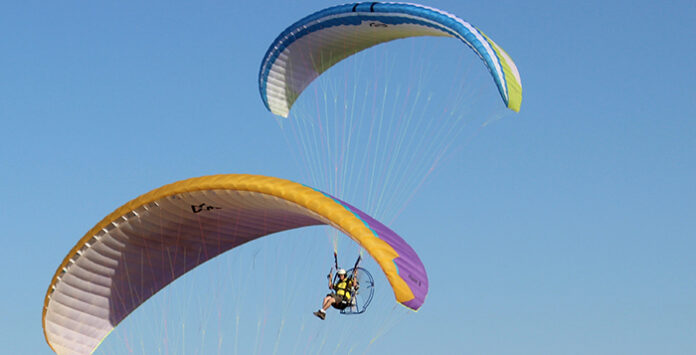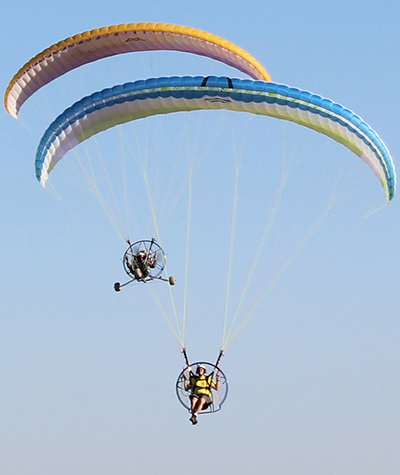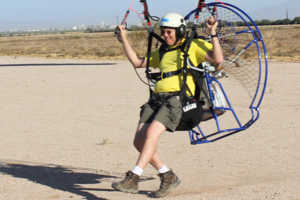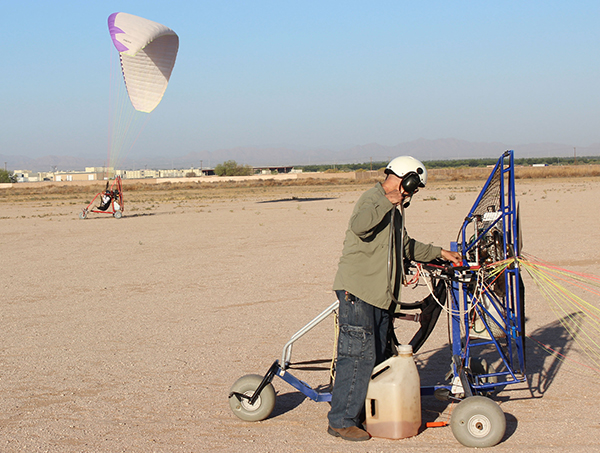
By Ethan McSweeney
The vehicle Mo Sheldon climbs into on an early Wednesday morning at Ak-Chin Regional Airport looks more like it belongs on a go-kart track than hundreds of feet in the air.
But the vehicle, known as a paramotor, has three wheels and a large propeller in the back. It takes off with a loud whir and a canopy floating overhead and pitches up toward the sky.
Sheldon, owner of Airparamo, has been flying paramotors for nearly two decades, and his business has attracted a loyal following around the state. In the early morning hours when the air is still cool, paramotor enthusiasts will bring their vehicles to an unpaved part of the Ak-Chin Regional Airport, just east of Maricopa, to fly.
“I feel very privileged and lucky to be able to share this with other people,” Sheldon said.
Paramotoring, also known as powered paragliding, can involve vehicles with wheels or foot-launch devices, as the motor powers them and the parasail allows pilots to steer. Airparamo, located on West Trading Post Road near the airport, offers tandem flights — Sheldon will take people up in the air — flying instruction, gear, consulting and manufacturing services for paramotors.

Sheldon’s desire to fly began early in life. He grew up in Caracas, Venezuela, where his parents worked, and watched seagulls near the ocean. “I always wanted to fly like a bird,” he said.
After going to school at the University of Rochester in upstate New York and Washington University in St. Louis, Sheldon got his master’s degree in architecture and worked in the field for six years before getting into computers.
Sheldon and his wife moved to Arizona because her family lived in the state. Once here, he began to tap into his desire to fly.
He took lessons in planes, but, he said, those “didn’t quite do it” for him. Then he came across paramotors, which he said made him feel like a bird flying in the open air. “I was hooked,” he said.
Sheldon began flying paramotors in 1998 and launched Airparamo in 2001 with the tagline “Fly Like A Bird.” With the business, he began offering paramotor flying lessons himself.
Paramotors don’t require a license to fly — teaching how to fly one does, however — and are considered “ultralight” aircraft by the Federal Aviation Administration.
How fast or how long one can fly depends on several different factors, Sheldon said, such as weight, the type of motor, barometric pressure and the temperature outside. Paramotors can also reach thousands of feet in altitude, but, Sheldon said, that’s usually not the point of flying them.
“Most of the time it’s not about how high you can fly, it’s about how low you can fly,” Sheldon said.
Living in Gilbert when he first started flying paramotors, Sheldon came to Maricopa to what was then Phoenix Regional Airport to its purchase by the Ak-Chin Indian Community, to fly and then offer lessons.
Sheldon has flown paramotors around the United States, France, Spain, Mexico and Colombia, but, he said, one of the best places in the world to fly is in Arizona and the Maricopa area in particular. The proximity to open pit mines and the Sonoran Desert National Monument make the area a particularly interesting and scenic place to fly, Sheldon said.

“We really live in a very special place to be able to fly,” he said.
In the early 2000s, Sheldon decided to move his family to Maricopa, with the city booming and home prices low, to get closer to the airport.
Jay Kocherhans is one person who got addicted to paramotors after meeting Sheldon.
Kocherhans was interested in learning how to fly a paramotor, and Sheldon was the first name to come up when he searched the Internet for instructors about four years ago.
After flying with Sheldon, Kocherhans became so enthralled with flying paramotors that he moved from Mesa to a house right next to the Ak-Chin Regional Airport so he could “fly every day,” he said.
“The only thing that keeps me on the ground is bad weather,” he said.
Others will commute from the East Valley or as far away as Tucson to fly at the airport with Sheldon.
“I like being in the air. I don’t have red lights or green lights or people tailgating me,” Kocherhans said. “I can go up and look at the chaos below.”
Kocherhans said he would like to see more Maricopans come out to fly at the airport, a point on which Sheldon agrees.
Among the opportunities for Maricopans’ to witness paramotoring first-hand is Sheldon’s annual Arizona Flying Circus, which he said brought out 300 to 500 people last year.
The Flying Circus, which is scheduled for February, is described as “part fly-in, part Burning Man, part Wild West,” according to its website, and brings out paramotors, hot air balloons and other types of aircraft.
“I would love to see a larger Maricopa presence,” Sheldon said. “We have an incredible resource here.”

This story appears in the October issue of InMaricopa.

![MHS G.O.A.T. a ‘rookie sleeper’ in NFL draft Arizona Wildcats wide receiver Jacob Cowing speaks to the press after a practice Aug. 11, 2023. [Bryan Mordt]](https://www.inmaricopa.com/wp-content/uploads/2024/04/cowing-overlay-3-218x150.png)




![Maricopa’s ‘TikTok Rizz Party,’ explained One of several flyers for a "TikTok rizz party" is taped to a door in the Maricopa Business Center along Honeycutt Road on April 23, 2024. [Monica D. Spencer]](https://www.inmaricopa.com/wp-content/uploads/2024/04/spencer-042324-tiktok-rizz-party-flyer-web-218x150.jpg)





![Alleged car thief released without charges Phoenix police stop a stolen vehicle on April 20, 2024. [Facebook]](https://www.inmaricopa.com/wp-content/uploads/2024/04/IMG_5040-218x150.jpg)

![MHS G.O.A.T. a ‘rookie sleeper’ in NFL draft Arizona Wildcats wide receiver Jacob Cowing speaks to the press after a practice Aug. 11, 2023. [Bryan Mordt]](https://www.inmaricopa.com/wp-content/uploads/2024/04/cowing-overlay-3-100x70.png)


